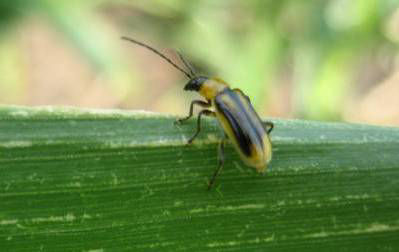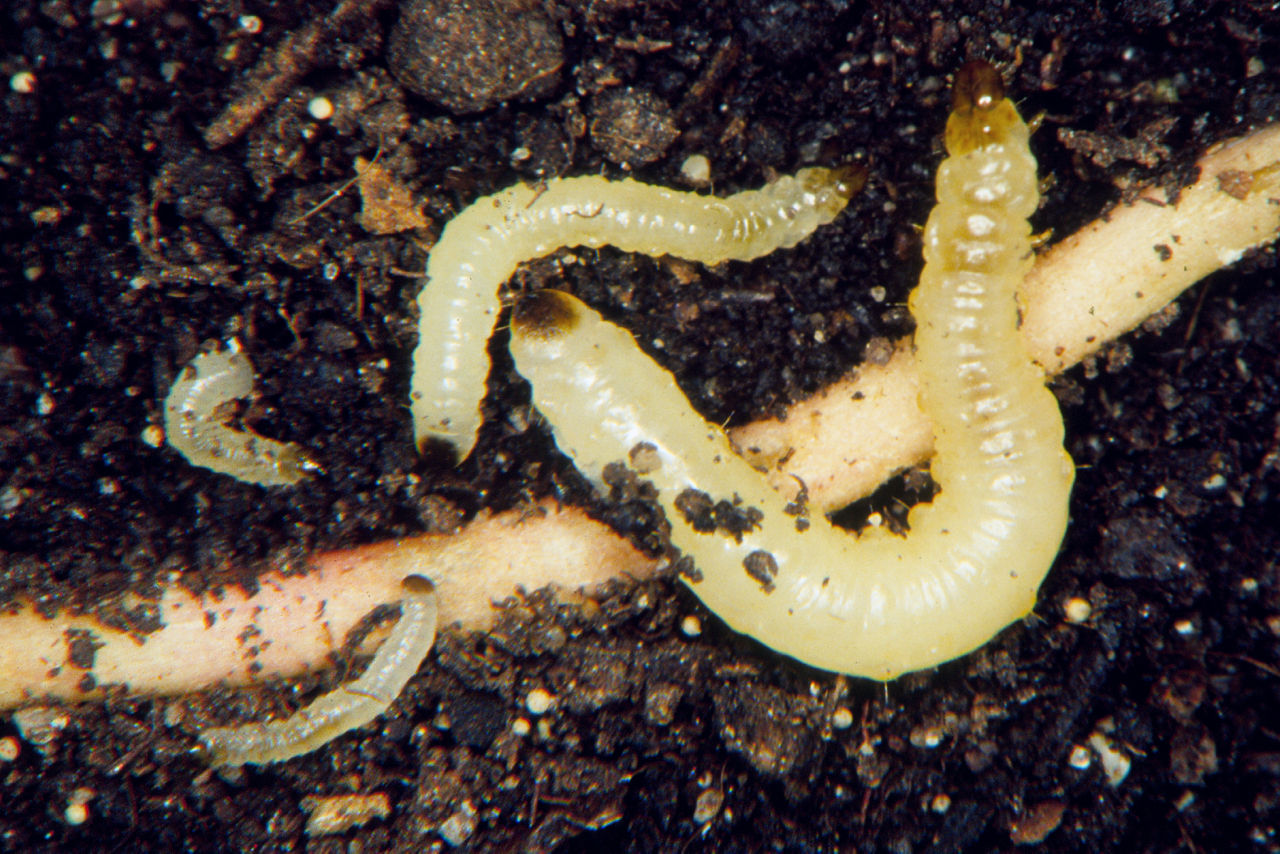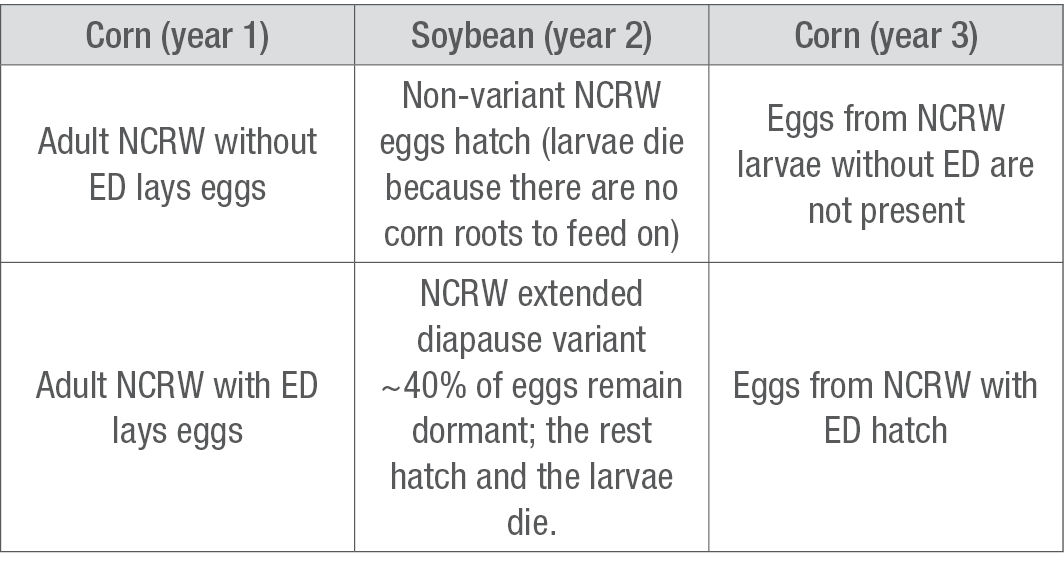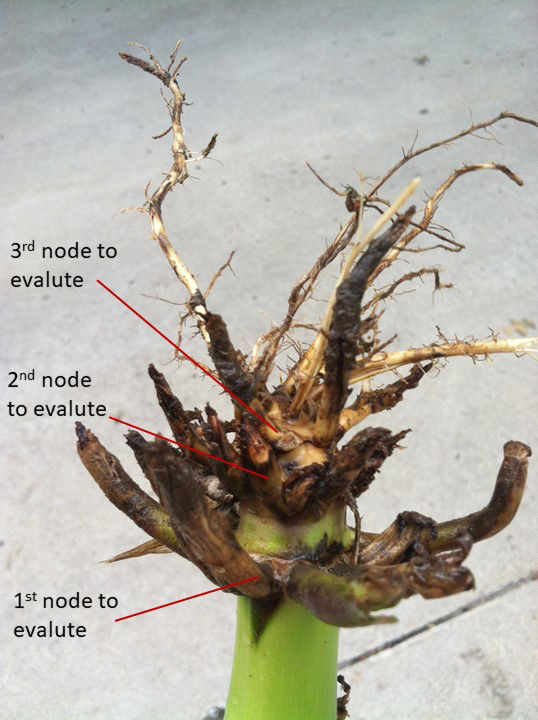Northern Corn Rootworm and Extended Diapause
August 2, 2023
- Northern corn rootworm (NCRW) is one of two prominent corn rootworm (CRW) pests in the Midwestern states.
- Extended diapause allows a portion of eggs to overwinter, remain dormant during summer, overwinter again, and hatch the second summer. In some cases, smaller amounts of eggs may lay dormant for up to 4 years.
- The most notable CRW injury from larvae is feeding damage to the root system. Adult CRW feeding is primarily focused on silk clipping, which can interfere with pollination.
- Successful NCR management is possible when multiple best management practices (BMPs) such as crop rotation, adult scouting, and foliar spray applications are used. In some cases, use of a CRW traited product for first year corn may be warranted to manage NCR.
Identification and Comparison
The northern corn rootworm (Diabrotica barberi Smith & Lawrence) and the western corn rootworm (Diabrotica virgifera virgifera LeConte) (WCRW) are the prominent CRW pests in the Midwestern states. While larvae of WCRW and NCRW may look very similar, adults can be readily distinguished from one another. NCRW adults are approximately ¼-inch long and are cream to tan in color upon emergence but turn a pale green over time (Figure 1). The WCRW adult is yellow to green in color, with three black stripes on the wing covers, and can range from 1/4-inch to 5/16-inch in length (Figure 2).1 The stripes on male WCRW usually appear wider and may coalesce. The females of the two species are generally larger than the males.


Life Cycle
Both NCRW and WCRW have a similar lifecycle: egg, larva, pupa, and adult. The eggs of the two species overwinter and begin hatching in late May or early June. Freeze-thaw cycles increase CRW egg mortality, so weather events that reduce the number of freeze-thaw cycles, such as mild winters or extended snow cover, may decrease egg mortality. Additionally, the deeper the eggs are laid, the more they are buffered from cold air temperatures. Snow cover and crop residue can insulate overwintering CRW eggs in the soil as well.6 When the eggs hatch after overwintering, carbon dioxide (CO2) emitted from corn roots attracts the larvae2 (Figure 3). While feeding for three to four weeks, the larvae pass through three growth stages, or instars, with pupation following the last instar. Adults generally begin emerging in late July and August, and then start feeding on corn leaves, pollen, and silks.1

Northern Corn Rootworm Extended Diapause
In a number of areas within the upper Midwest, NCRW has developed an adaptation known as extended diapause. This common adaptation—the ability to produce a portion of their eggs that remain dormant for one or more growing seasons—is a significant feature that sets NCRW apart from WCRW (Table 1). Extended diapause might position some the hatching eggs into some first-year corn fields following soybean rotation. In some cases, fields planted to products without root protection may see damage from larval feeding that may become economically important. Areas in Nebraska, Minnesota, Iowa, South Dakota, and Wisconsin have been affected by this genetic variant more than other Midwestern states.
Table 1. Crop rotation and survival of extended diapause (ED) northern corn rootworms.

Best Management Practices
To successfully manage corn rootworm, growers should use multiple best management practices (BMPs). BMPs can include rotation, scouting, soil-applied and/or foliar insecticide applications when warranted, and planting corn products with multiple modes of action for below-ground insect protection. SmartStax® PRO with RNAi Technology offers three modes of action for below-ground insect protection and SmartStax® RIB Complete offers two modes of action.
When extended diapause variants are present, additional management may be required.
- Rotate to non-host crops to break the corn rootworm cycle. Where extended diapause variants are suspected, non-host rotation should be for at least two years.
- Plant corn products that have SmartStax® PRO with RNAi Technology or SmartStax® technology.
- If planting a corn product without a CRW trait, consider using a soil-applied insecticide at planting as needed. Soil moisture status, application timing, and placement are important for the efficacy of insecticides to protect plants for the duration of the larval feeding period.
- Scout regularly for early season larval feeding by digging roots to assess root damage.
- Monitor adult populations around tasseling to determine if adult control measures are needed to protect silks and ears, and to help predict infestation levels for the next corn crop. Consult your local extension entomologist for recommended spray thresholds.
- Manage weeds and volunteer corn in soybean fields (pollinating weeds and corn can attract CRW adult beetles resulting in greater egg deposition in that location).6
Corn rootworms, regardless of species, are extremely adaptable insects. It is important to have an integrated, defensive approach to managing the pest both now and in the future. Successful management of CRW begins with scouting your fields to gather valuable information to help determine which control tactics may be necessary.
Scout and Protect Roots — The most notable injury from CRW larval feeding is the injury to the root system. Root injury subjects the plant to increased stress from drought, compaction, inadequate fertility, and other harmful factors, and can increase the potential for significant yield reduction. Root lodging is also a possibility, which can make harvest difficult.
In continuous corn operations where CRW populations are known to exist, or where NCRW extended diapause variants were known to be present in a corn crop two years prior and root lodging occurred, corn products with biotechnology traits for below-ground insect protection should be considered.
If corn products without biotechnology traits are planted into continuous corn situations or when extended diapause variants were known to be present in a corn crop two years prior and root lodging occurred, a soil-applied insecticide (SAI) should be considered. However, SAIs may be difficult to handle, require expensive application equipment that most growers who rotate are lacking, add costs, and have been known to be inconsistent in their performance. Additionally, digging corn roots in late July is imperative to help evaluate CRW larval damage and assess CRW management strategies. The Iowa State Node-Injury Scale can be used to evaluate feeding damage (Figure 4).5 For information on how to conduct a root dig and evaluate corn roots for damage from CRW feeding, please refer to the following article: https://www.cropscience.bayer.us/articles/bayer/conducting-root-digs-for-corn-rootworm

Scout and Protect Silks — Adult CRW populations should be monitored when the corn is tasseling to determine if adult control measures are warranted to protect silks from clipping. Silk clipping can prevent ovule fertilization, which results in aborted kernels. In some regions, the economic threshold of five beetles per plant may justify a foliar insecticide application to protect silks.4 Consult local extension entomologists for recommended thresholds that should be followed. Adult scouting can also help determine the potential for infestation in future corn crops. Managing adults CRW beetles can suppress egg laying, which may prevent large populations from developing and causing root damage the following year. But keep in mind, successful adult management programs require a grower to commit to regularly scouting crops throughout the grain fill period.
Bottom line — Successful management of NCRW with extended diapause requires multiple tactics over a period of years. It may be difficult to single out one tactic that by itself led to the success or failure of controlling NCRW. The level of infestation in any given year may be the result of control measures that were or were not taken in previous years, or it may be the result of a culmination of multiple factors, including some that cannot be controlled such as climatic conditions.
Sources
1 Corn rootworms. 2009. Field Crops IPM. Purdue University. https://extension.entm.purdue.edu/fieldcropsipm/insects/corn-rootworms.php
2 Sandall, L., Pilcher, C., and Namuth, D. 2003. Corn rootworm - part 1: Description of corn rootworm and other early season corn pests. Plant & Soil Sciences eLibrary. USDA, NIFA. https://passel2.unl.edu/view/lesson/7b67b9a3d065/4
3 Ostlie, K. 2002. [Presentation] Roots of evil: corn rootworms and crop rotations. University of Minnesota. Learning Ace. https://extension.soils.wisc.edu/wp-content/uploads/sites/68/2016/07/Ostlie2.pdf
4 Cullen, E. 2012. Corn rootworm beetle emergence and feeding in corn fields. Integrated Pest and Crop Management. University of Wisconsin-Madison. https://ipcm.wisc.edu/blog/2012/07/corn-rootworm-beetle-emergence-and-feeding-in-corn-fields/
5 VanDyk, J. 2001. Interactive node-injury scale. Iowa State University. https://www.ent.iastate.edu/pest/rootworm/nodeinjury/nodeinjury.html
6Biological & cultural control. Corn Rootworm IPM Regional Working Group. Iowa State University https://cornrootworm.extension.iastate.edu/biological-cultural-control
Web sources verified 7/21/2023. 1215_274740